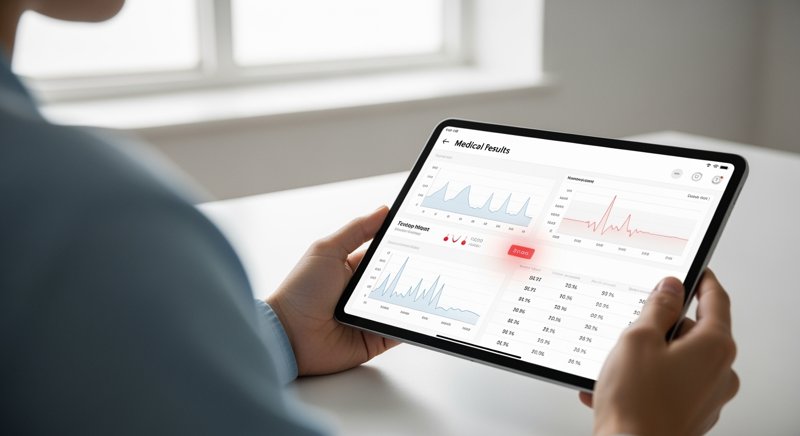🎯 Beyond 'Normal': A Patient's Guide to Optimal Health Ranges

You’ve just received your annual lab report. You scan the page, and with a sigh of relief, you see that nearly every value falls within the “normal” reference range. Your doctor gives you a clean bill of health. But as you walk out of the clinic, a nagging question remains: if everything is “normal,” why don’t I feel great?
This is one of the most common frustrations in modern healthcare, and it stems from a fundamental misunderstanding of what “normal” really means. It’s time to upgrade our thinking and move beyond the simple absence of disease to the active pursuit of optimal health.
The “Normal” Range: A Bar Set for Disease, Not for Wellness
As we’ve explored in our guide to decoding lab work, a standard reference range is a statistical tool designed to identify overt disease. It’s based on a bell curve of a broad population, which unfortunately includes many people with subclinical, undiagnosed health issues.
Being “in the normal range” simply means you are not yet sick enough to be diagnosed with a specific disease. It does not mean you are in a state of peak wellness. This is the crucial distinction that is at the heart of preventive, functional, and longevity medicine.
The “Optimal” Range: A Target for Thriving
The optimal range is a much narrower band of values that is not based on the statistics of a sick population, but on the science of what levels are associated with the lowest risk of future disease and the highest level of function.
| Biomarker | Standard “Normal” Range | Functional “Optimal” Range | Why It Matters |
|---|---|---|---|
| Fasting Glucose | < 100 mg/dL | 75-85 mg/dL | Levels in the high-normal range are a strong predictor of future diabetes and metabolic syndrome. The optimal range reflects excellent insulin sensitivity. |
| Vitamin D | 30-100 ng/mL | 50-80 ng/mL | While 30 prevents rickets, levels above 50 are associated with a more robust immune system, better mood, and lower risk of many chronic diseases. |
| TSH (Thyroid) | 0.5-4.5 mIU/L | 0.5-2.0 mIU/L | Many patients, particularly women, experience symptoms of subclinical hypothyroidism (fatigue, weight gain, hair loss) when their TSH is in the high-normal range. |
| hs-CRP (Inflammation) | < 3.0 mg/L | < 1.0 mg/L | While under 3.0 is considered “average risk,” a level under 1.0 indicates a very low level of the chronic inflammation that drives most age-related diseases. |
This is a paradigm shift. The goal is not just to avoid a diagnosis, but to proactively steer your biology toward a state of peak performance and resilience.
The Power of the Early Warning
Chronic diseases don’t appear overnight. They are the result of a long, slow burn of dysfunction that can smolder for years or even decades before a diagnosis is made. By the time your fasting glucose is high enough to be diagnosed as diabetes, your metabolic health has been declining for a long time.
Aiming for optimal ranges allows you and your doctor to catch these dysfunctions at the earliest possible stage, when they are most reversible with lifestyle interventions. It’s the difference between noticing a small crack in the foundation and waiting for the wall to collapse.
How to Have the “Optimal” Conversation with Your Doctor
Many conventionally trained doctors focus primarily on the standard reference ranges. To have a productive conversation about optimal health, you need to be an empowered, educated patient.
- Track Your Trends: Keep a record of your key biomarkers over time. A rising trend, even within the normal range, is a powerful piece of data to bring to your doctor.
- Correlate with Symptoms: If your TSH is “normal” at 4.2, but you have all the classic symptoms of hypothyroidism, that’s a valid point of discussion.
- Ask Proactive Questions:
- “I know my result is in the normal range, but I’m interested in achieving an optimal level for long-term health. What would that be for this marker?”
- “I see this value has been trending up over the past few years. What proactive steps can I take now to reverse this trend?”
- Find the Right Partner: Seek out a physician trained in functional or preventive medicine who is fluent in the language of health optimization.
The future of medicine is personal and proactive. It’s about using data not just to diagnose disease, but to build a roadmap to a longer, healthier, and more vibrant life. By shifting your focus from “normal” to “optimal,” you are moving from the passenger seat to the driver’s seat of your own health journey.
AI Tools for Optimization: When pursuing optimal health ranges, having the right analytical tools matters. Purpose-built medical AI systems differ fundamentally from general chatbots in their ability to identify subtle patterns across multiple biomarkers. While wellness platforms like InsideTracker focus on optimization zones, medical-grade AI provides the clinical precision needed to work effectively with your healthcare provider. Understanding these differences between AI models helps you choose the right tool for your health optimization journey.





